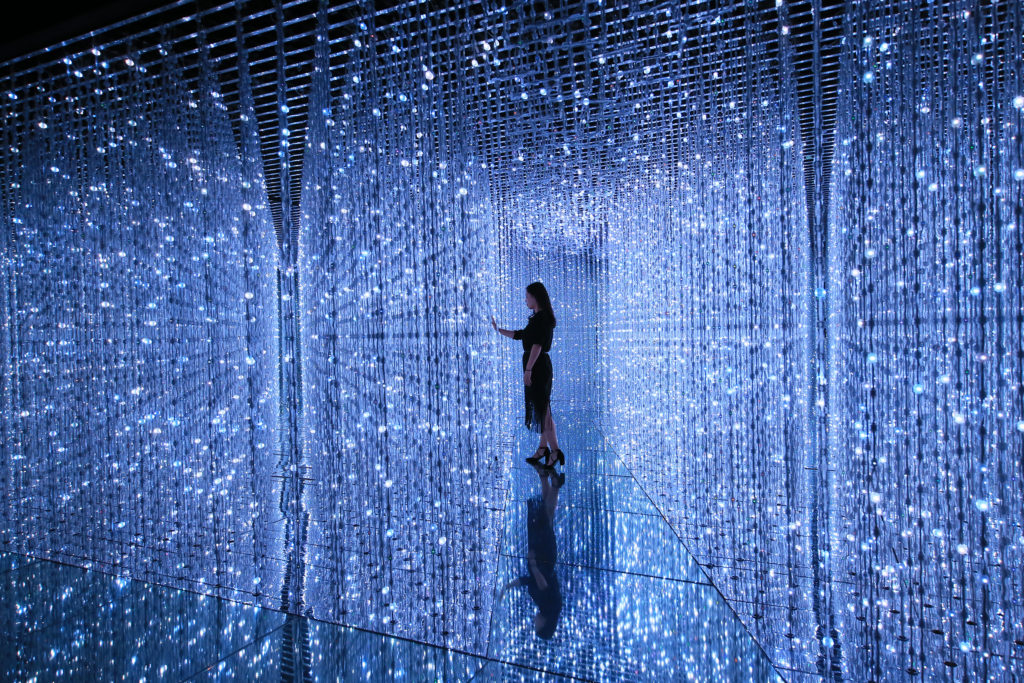
‘Crystal Universe’, an installation by Toshiyuki Inoko, is one of the highlights of teamLab’s ongoing show in Shenzhen. PHOTO via CHINA DAILY/Asia News Network
What happens when art, food and technology meet?
Fish swim through diners, birds perch on dishes and butterflies dance around flowers growing on food.
That is what Tokyo-based art group teamLab is offering people in Shenzhen.
The immersive dining room in the southern Chinese city’s B. Park restaurant, opened on Oct. 1, making it the second of its kind in the world produced by teamLab, an interdisciplinary collective that gathers more than 400 professionals from various fields to create installations combining technology and art.
The first such art restaurant opened in Tokyo in April.
The eatery in Shenzhen is an upgraded version of its Tokyo counterpart, with enhanced technology, says Toshiyuki Inoko, teamLab founder.
When a plate of food is placed on the table, sensors recognize it and project real-time animations on it, accompanied by matched animations covering the walls and a long dining table. During the 11-course kaiseki dining experience, the scenes change based on each dish offered, including blazing maples, waterfalls, bamboo forests and yellow reeds.
People can interact with the animation by either touching them or moving their plates. For instance, birds fly away from one’s dish to trees on the wall if a person touches it.
“The challenge lies in the recognition part: how to let our system accurately recognize plates, wineglasses and customers’ belongings put on a table, like phones, keys or wallets,” says Inoko.
Technology is the canvas on which such art is produced.
“It breaks the boundaries between artworks and viewers, allowing them to interact with each other,” the 40-year-old artist adds.
Digital art installations by Inoko and his “ultra-technologist” team have intrigued visitors to their shows across the world, including in London, New York and Tokyo in recent years. And, visitors in China are no exception.
By the end of September, the number of visitors to team-Lab’s ongoing show in Shenzhen had reached 300,000. The show, the biggest ever by team-Lab, opened in Shenzhen in July, with 16 large-scale interactive and digital art installations in an exhibition space about the size of six tennis courts.
Half of the works on display are interactive installations designed for children. The rest are digital installations, including a 56-meter-long screen with various animals made up by flowers “walking” on it.
Talking about the art restaurant, Inoko says he was inspired by the patterns on porcelain wares produced in Arita in Japan when teamLab displayed interactive installations there in 2014. One year later, his art collective created interactive works involving plates and cups at a coffee shop in Paris-that’s where the idea to set up a multisensory dining room came from.
“People are an important part in our works. Diners at a table may not know each other. But the animations inspired by the dishes (served) can react to each other based on their behaviour and make a better world together,” Inoko says.
The eatery offers eight seats per meal. Each is priced at 2,500 yuan ($378).
The newly opened restaurant and teamLab’s show are both brought to Shenzhen by Blooming Investment, a local company that focuses on art and culture projects.
Yang Juze, founder of the company, says it cost 4 million yuan to set up the 60-square-metre dining room. He plans to run it for only a year.
Another such project with teamLab will be launched in Shanghai later.
Yang explains that Shenzhen is known for its high-tech industry, which is why he thought of bringing the immersive restaurant there.
The number of visitors to the show has already made a record for paid shows in the city. Customers have to wait for at least one month to try the experience because of prior reservations and limited seats per day.
TeamLab’s works rely on multidisciplinary teams of engineers, programmers and architects.
Zhong Qiaorong, a project director with teamLab, says that more than 100 people work in the technology side of the Japanese company. Their works involve lights, sounds, virtual reality and machinery that provide art, which attracts young people who post photos of such shows to social media.
Inoko, who founded team-Lab in 2001, says the world is changing and people’s traditional opinion on art should also change.
“Art needs to be interactive,” he says. Unlike the conventional experience in art museums-where people prefer to appreciate art by themselves or in a quiet environment-Inoko’s works need many people’s involvement, he explains.
Inoko takes his work Forest of Resonating Lamps displayed in Shenzhen as an example. It consists of thousands of lamps that can resonate with people’s behaviour. Visitors are aware of others’ presence in the same space according to the changes of lights on the other side of the show room.
“All my works are exploring the relationship between humans and nature, as well as how people should get along with the world,” he adds.
That’s why teamLab artists widely use elements from nature, such as waterfalls, flowers, trees, forests and animals, to create an interactive world with the visitors involved, Inoko explains.